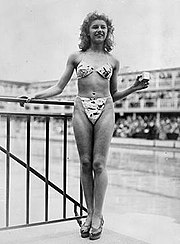 A bikini or two-piece is a type of women's swimsuit, characterized by two separate parts — one covering the breasts (optionally in the case of the monokini), the other the groin (and optionally the buttocks), leaving an uncovered area between the two garments. It is often worn in hot weather or while swimming. The shapes of both parts of a bikini closely resemble women's underwear, and the lower part of a bikini can therefore range from the more revealing thong or g-string, to briefs, and modest square-cut shorts.
A bikini or two-piece is a type of women's swimsuit, characterized by two separate parts — one covering the breasts (optionally in the case of the monokini), the other the groin (and optionally the buttocks), leaving an uncovered area between the two garments. It is often worn in hot weather or while swimming. The shapes of both parts of a bikini closely resemble women's underwear, and the lower part of a bikini can therefore range from the more revealing thong or g-string, to briefs, and modest square-cut shorts.
History
---------------------------------------------------------------------------------------
 Two-piece garments worn by women for athletic purposes have been observed on Greek urns and paintings, dated as early as 1400 BC. Ancient artwork from over 1700 years ago in Villa Romana del Casale have depicted women in garments resembling modern-day bikinis.. Other bikini-style swimwear existed for many years before the first official bikini. Films of holidaymakers in Germany in the 1930s show women wearing two-piece bathing suits. They were to be seen again a year later in Gold Diggers of 1933. Two-piece swimsuits started appearing in the US when the U.S. Government ordered a 10 percent reduction in the fabric used in woman's swimwear in 1943 as part of wartime rationing. The July 9, 1945 issue of Life shows women in Paris wearing similar items.
Two-piece garments worn by women for athletic purposes have been observed on Greek urns and paintings, dated as early as 1400 BC. Ancient artwork from over 1700 years ago in Villa Romana del Casale have depicted women in garments resembling modern-day bikinis.. Other bikini-style swimwear existed for many years before the first official bikini. Films of holidaymakers in Germany in the 1930s show women wearing two-piece bathing suits. They were to be seen again a year later in Gold Diggers of 1933. Two-piece swimsuits started appearing in the US when the U.S. Government ordered a 10 percent reduction in the fabric used in woman's swimwear in 1943 as part of wartime rationing. The July 9, 1945 issue of Life shows women in Paris wearing similar items.
 According to the official version, the modern bikini was invented by French engineer Louis Réard and fashion designer Jacques Heim in Paris in 1946 and introduced on July 5 at a fashion show at Piscine Molitor in Paris. It was a string bikini with a g-string back. It was named after Bikini Atoll, the site of a nuclear weapon test called Operation Crossroads on July 1 in the Marshall Islands, on the reasoning that the burst of excitement it would cause would be like the nuclear device. Monokini, a bikini variant, derives its name, as a back formation, from bikini, interpreting the first syllable as the Latin prefix bi- "two" and substituting for it mono- "one", on the (perhaps intentionally) mistaken notion that the bi- element was the Greek prefix meaning "two". Réard's suit was a refinement of the work of Jacques Heim who, two months earlier, had introduced the "Atome" (named for its size) and advertised it as the world's "smallest bathing suit". Réard "split the 'atom'" even smaller, but could not find a model who would dare to wear his design. He ended up hiring Micheline Bernardini, a nude dancer from the Casino de Paris as his model.
According to the official version, the modern bikini was invented by French engineer Louis Réard and fashion designer Jacques Heim in Paris in 1946 and introduced on July 5 at a fashion show at Piscine Molitor in Paris. It was a string bikini with a g-string back. It was named after Bikini Atoll, the site of a nuclear weapon test called Operation Crossroads on July 1 in the Marshall Islands, on the reasoning that the burst of excitement it would cause would be like the nuclear device. Monokini, a bikini variant, derives its name, as a back formation, from bikini, interpreting the first syllable as the Latin prefix bi- "two" and substituting for it mono- "one", on the (perhaps intentionally) mistaken notion that the bi- element was the Greek prefix meaning "two". Réard's suit was a refinement of the work of Jacques Heim who, two months earlier, had introduced the "Atome" (named for its size) and advertised it as the world's "smallest bathing suit". Réard "split the 'atom'" even smaller, but could not find a model who would dare to wear his design. He ended up hiring Micheline Bernardini, a nude dancer from the Casino de Paris as his model.
 Catholic countries like Spain, Portugal and Italy banned the bikini. Decency leagues pressured Hollywood to keep bikinis from being featured in Hollywood movies. One writer described it as a "two piece bathing suit which reveals everything about a girl except for her mother's maiden name." Movie star Esther Williams once said: "A bikini is a thoughtless act." Brigitte Bardot helped popularize the bikini in Europe in the 1950s, but the United States took longer to adopt it. Modern Girl magazine wrote in 1957, "It is hardly necessary to waste words over the so-called bikini since it is inconceivable that any girl with tact and decency would ever wear such a thing."
Catholic countries like Spain, Portugal and Italy banned the bikini. Decency leagues pressured Hollywood to keep bikinis from being featured in Hollywood movies. One writer described it as a "two piece bathing suit which reveals everything about a girl except for her mother's maiden name." Movie star Esther Williams once said: "A bikini is a thoughtless act." Brigitte Bardot helped popularize the bikini in Europe in the 1950s, but the United States took longer to adopt it. Modern Girl magazine wrote in 1957, "It is hardly necessary to waste words over the so-called bikini since it is inconceivable that any girl with tact and decency would ever wear such a thing."
In 1951 bikinis were banned from the Miss World Contest following the crowning of Miss Sweden in a bikini and subsequent protests with a number of countries threatening to withdraw. In 1957, however, Brigitte Bardot's bikini in And God Created Woman created a market for the swimwear in the US, and in 1960, Brian Hyland's pop song "Itsy Bitsy Teenie Weenie Yellow Polka Dot Bikini" inspired a bikini-buying spree. By 1963, the movie Beach Party, starring Annette Funicello (emphatically not in a bikini, by mentor Walt Disney's personal request) and Frankie Avalon, led a wave of films that made the bikini a pop-culture symbol.
The sex appeal of the apparel prompted numerous film and television productions as much as public morals. They include the numerous surf movies of the early 1960s. Dr. Strangelove was among these first movies to feature a bikini in memorable scenes. The elaborately and lavishly assembled Busby Berkeley film spectacle, Footlight Parade of 1932 showcases stunning aquachoreography that profusely featured what could only be regarded as bikini swimwear.
 In 1962, an icon was born as Bond Girl Ursula Andress emerged from the sea wearing a white bikini in Dr. No. Other iconic portrayals of bikinis in movies include Raquel Welch as the prehistoric cavegirl in the 1966 film One Million Years B.C., and Phoebe Cates in the 1982 teen film Fast Times at Ridgemont High. These three scenes were recently ranked 1, 86, and 84 respectively in Channel 4 (UK)'s 100 Greatest Sexy Moments in Film. The Dr. No bikini scene has been quoted as one of the most memorable scenes from the British spy film series. Virgin Media puts it in 9th position in its list of top ten movie bikini, and the top position in the list for top ten Bond girls. The Herald (Glasgow) put the scene as best ever bikini scene on the basis of a poll. It also helped shape the career of Ursula Andress, the look of the quintessential Bond movie. According to Andress, "This bikini made me into success." That white bikini has been described as a "defining moment in the sixties liberalization of screen eroticism".
In 1962, an icon was born as Bond Girl Ursula Andress emerged from the sea wearing a white bikini in Dr. No. Other iconic portrayals of bikinis in movies include Raquel Welch as the prehistoric cavegirl in the 1966 film One Million Years B.C., and Phoebe Cates in the 1982 teen film Fast Times at Ridgemont High. These three scenes were recently ranked 1, 86, and 84 respectively in Channel 4 (UK)'s 100 Greatest Sexy Moments in Film. The Dr. No bikini scene has been quoted as one of the most memorable scenes from the British spy film series. Virgin Media puts it in 9th position in its list of top ten movie bikini, and the top position in the list for top ten Bond girls. The Herald (Glasgow) put the scene as best ever bikini scene on the basis of a poll. It also helped shape the career of Ursula Andress, the look of the quintessential Bond movie. According to Andress, "This bikini made me into success." That white bikini has been described as a "defining moment in the sixties liberalization of screen eroticism".
 Ultimately the bikini caught on, due to a host of films and songs featuring the garment in the early 1960s. In Malta, bikinis took time to be introduced. In the 1960s, the police fended off Bishop Michael Gonzi's request to ban bikini clad tourists following fear of compromising Malta as a tourist destination. Malta Labour Party girls felt safe putting on bikinis during beach parties but this was unacceptable by those supporting the Nationalist Party. The lower part of the bikini was further reduced in size in the 1970s to the Brazilian thong, where the back of the suit is so thin that it disappears into the buttocks.
Ultimately the bikini caught on, due to a host of films and songs featuring the garment in the early 1960s. In Malta, bikinis took time to be introduced. In the 1960s, the police fended off Bishop Michael Gonzi's request to ban bikini clad tourists following fear of compromising Malta as a tourist destination. Malta Labour Party girls felt safe putting on bikinis during beach parties but this was unacceptable by those supporting the Nationalist Party. The lower part of the bikini was further reduced in size in the 1970s to the Brazilian thong, where the back of the suit is so thin that it disappears into the buttocks.
In 1996, when the Miss World contest was held in Bangalore, a dozen Indian groups opposed the event claiming that the contest degraded women by featuring them in bikinis. Social activist Subhashini Ali commented, "It's not an IQ test. Neither is it a charity show. It's a beauty contest in which these things have been added on as sops." The protests were so intense that the organizers were finally compelled to shift the venue of the "Swimsuit Round" to Seychelles. Afghan Miss Earth 2003 contestant Vida Samadzai was severely condemned by the Afghan Supreme Court, which said, "such a display of the female body goes against Islamic law and Afghan culture."











1 comments:
thanks to Esther Williams for popularizing brazilian bikini! If it wasn't for her, the world would be boring :))
Post a Comment